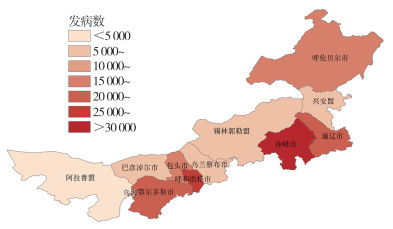Epidemiological characteristics of hand-foot-mouth disease in Inner Mongolia Autonomous Region from 2009 to 2018
-
摘要:
目的 探讨内蒙古自治区2009-2018年手足口病流行病学和季节性特征。 方法 对内蒙古自治区2009-2018年手足口病(hand-foot-mouth disease, HFMD)监测数据进行统计分析,采用集中度和圆形分布法分析其季节性特征。 结果 2009-2018年内蒙古自治区共178 063例报告病例,年均报告发病率是71.99/10万,发病率总体呈下降趋势(χ2趋势=3 584.162, P < 0.001)。累计报告重症病例数为1 216例,总体呈下降趋势(χ2趋势=8.772, P < 0.001)。发病集中度M=0.876,有很强的季节性;圆形分布r=0.523,α=209.446°(144.187°, 274.705°)(Z=48 660.177, P < 0.001),发病高峰日为7月16日,流行高峰期为5月2日至9月26日。重症集中度M=0.919,有严格的季节性;圆形分布r=0.592,α=210.688°(152.025°, 269.352°)(Z=426.240, P < 0.001),重症高峰日为8月3日,重症高峰期为6月4日至11月1日;乌海市发病率最高(176.91/10万),不同盟市年均发病率差异有统计学意义(χ2=1 548.865, P < 0.001),Moran’s Index=-0.023(P=0.688), 提示不存在地区聚集性;发病人群以≤10岁儿童(98.82%)为主,以散居儿童(48.50%)和幼托儿童(42.31%)为主,男女发病率差异有统计学意义(χ2=30.482, P < 0.001)。 结论 内蒙古自治区HFMD发病率总体呈逐年下降趋势,但仍需继续做好防控工作。 Abstract:Objective To analyzed the epidemiological and seasonal characteristics of hand-foot-mouth disease (HFMD) in Inner Mongolia Autonomous Region from 2009 to 2018. Methods The surveillance data of HFMD in Inner Mongolia Autonomous Region from 2009 to 2018 were analyzed using statistic methods, and concentration method and circular distribution method were used to analyze the seasonal variations. Results A total of 178 063 cases were reported in Inner Mongolia Autonomous Region from 2009 to 2018, with an annual average reported incidence of 71.99 per 100 000. The overall incidence showed a downward trend (χ2trend=3 584.162, P < 0.001). A total of 1 216 severe cases were reported, revealing an overall downtrend (χ2trend=8.772, P < 0.001). The incidence concentration ratio M-value was 0.876, exhibiting a strong seasonal characteristic. The concentration trend of HFMD circular distribution was 0.523, α=209.446° (144.187°, 274.705°) (Z=48 660.177, P < 0.001). The incidence was mainly reported between May 2 and September 26 and peaked on July 16. The severe cases concentration ratio M-value was 0.919, indicating a strict seasonality. The concentration trend of severe cases circular distribution was 0.592, α=210.688° (152.025°, 269.352°) (Z=426.240, P < 0.001). The most common peak day of severe cases was August 3, and the peak season was from June 4 to November 1. The incidence in Inner Mongolia Autonomous Region Wuhai City was highest (176.91/100 000), and the difference of the average annual incidence in different cities was statistically significant (χ2=1 548.865, P < 0.001). Moran's Index was -0.023 (P=0.688), suggesting that there was no regional aggregation. The cases were mainly concentrated in the population under 10 years old which accounted for 98.82%, in which scattered children and Kindergarten children accounted for 48.50% and 42.31%, respectively. There was statistically difference in morbidity between men and women (χ2=30.482, P < 0.001). Conclusions Though the incidence of HFMD in Inner Mongolia Autonomous Region had a downtrend with each passing year, prevention and control strategies were still needed to be carried out. -
表 1 2009-2018年内蒙古自治区HFMD发病概况
Table 1. General epidemic situation of HFMD in Inner Mongolia Autonomous Region from 2009 to 2018
年份 发病数(例) 发病率(/10万) 环比(%) 基比(%) 死亡数(例) 死亡率(/10万) 重症数(例) 重症率(%) 2009 32 253 133.62 100.00 100.00 3 0.01 0 0.00 2010 18 944 78.21 58.53 58.53 13 0.05 247 1.30 2011 23 234 94.04 120.24 70.38 9 0.04 368 1.58 2012 16 496 66.47 70.68 49.75 1 0.00 136 0.82 2013 16 535 66.41 99.91 49.70 5 0.02 90 0.54 2014 17 579 70.38 105.98 52.67 1 0.00 122 0.69 2015 12 217 48.77 69.30 36.50 0 0.00 65 0.53 2016 13 984 55.69 114.19 41.68 1 0.00 46 0.33 2017 15 447 61.30 110.07 45.88 1 0.00 104 0.67 2018 11 374 44.98 73.38 33.66 0 0.00 38 0.33 合计 178 063 71.99 - - 34 0.02 1 216 0.68 表 2 2009-2018年内蒙古自治区HFMD发病平均角
Table 2. Average angle of HFMD in Inner Mongolia Autonomous Region from 2009 to 2018
月份 月发病数(f,例) 月中值 sinα cosα f sinα f cosα 1 1 102 15 0.26 0.96 286.52 1 057.92 2 380 45 0.71 0.71 269.80 269.80 3 1 110 75 0.97 0.26 1 076.70 288.60 4 4 393 105 0.97 -0.26 4 261.21 -1 142.18 5 12 969 135 0.71 -0.71 9 207.99 -9 207.99 6 40 248 165 0.26 -0.97 10 464.48 -39 040.56 7 41 238 195 -0.26 -0.97 -10 721.88 -40 000.86 8 16 801 225 -0.71 -0.71 -11 928.71 -11 928.71 9 18 109 255 -0.97 -0.26 -17 565.73 -4 708.34 10 18 805 285 -0.97 0.26 -18 240.85 4 889.30 11 15 805 315 -0.71 0.71 -11 221.55 11 221.55 12 7 103 345 -0.26 0.97 -1 846.78 6 889.91 表 3 2009-2018年内蒙古自治区HFMD发病平均角
Table 3. Average angle of HFMD in Inner Mongolia Autonomous Region from 2009 to 2018
年份 平均角(°) 角离差(°) 发病高峰日 流行高峰期 r值 Z值 P值 2009 180.628 105.913 7月1日 3月15日-10月15日 0.181 5 842.067 < 0.001 2010 181.257 121.290 7月2日 2月29日-11月2日 0.106 2 015.439 < 0.001 2011 178.743 115.633 6月29日 3月3日-10月23日 0.130 3 031.617 < 0.001 2012 179.372 124.979 6月29日 2月22日-11月20日 0.093 1 528.212 < 0.001 2013 180.000 124.917 7月1日 2月25日-11月25日 0.093 1 535.447 < 0.001 2014 180.628 123.297 7月1日 2月23日-11月23日 0.099 1 735.460 < 0.001 2015 181.257 132.632 7月2日 2月13日-12月3日 0.069 838.215 < 0.001 2016 178.743 129.245 6月28日 2月6日-11月26日 0.079 1 098.219 < 0.001 2017 179.372 126.693 6月30日 2月25日-11月25日 0.087 1 340.030 < 0.001 2018 180.000 134.390 7月1日 3月6日-12月4日 0.064 726.529 < 0.001 表 4 2009-2018年内蒙古自治区HFMD重症平均角
Table 4. Average angle of severe HFMD in Inner Mongolia Autonomous Region from 2009 to 2018
月份 月发病数(f,例) 月中值 sina cosa f sina f cosa 1 9 15 0.26 0.96 2.34 8.64 2 2 45 0.71 0.71 1.42 1.42 3 5 75 0.97 0.26 4.85 1.30 4 6 105 0.97 -0.26 5.82 -1.56 5 46 135 0.71 -0.71 32.66 -32.66 6 303 165 0.26 -0.97 78.78 -293.91 7 318 195 -0.26 -0.97 -82.68 -308.46 8 158 225 -0.71 -0.71 -112.18 -112.18 9 113 255 -0.97 -0.26 -109.61 -29.38 10 106 285 -0.97 0.26 -102.82 27.56 11 108 315 -0.71 0.71 -76.68 76.68 12 42 345 -0.26 0.97 -10.92 40.74 表 5 2009-2018年内蒙古自治区HFMD重症圆形分布分析结果
Table 5. Circular distribution analysis results of severe HFMD in Inner Mongolia Autonomous Region from 2009 to 2018
年份 平均角(°) 角离差(°) 重症高峰日 重症高峰期 r值 Z值 P值 2009 180.000 112.290 7月1日 3月8日-10月22日 0.147 26.112 < 0.001 2010 181.402 103.445 7月2日 3月18日-10月15日 0.196 46.695 < 0.001 2011 178.568 90.073 6月29日 3月29日-9月27日 0.291 102.711 < 0.001 2012 179.280 123.037 6月29日 2月24日-11月18日 0.100 12.086 < 0.001 2013 180.000 124.917 7月1日 2月25日-11月25日 0.093 10.486 < 0.001 2014 180.636 123.147 7月1日 2月23日-11月23日 0.099 11.986 < 0.001 2015 181.176 137.961 7月2日 2月19日-12月9日 0.055 3.689 < 0.001 2016 179.023 143.522 6月29日 2月22日-12月12日 0.043 2.290 0.022 2017 179.378 126.819 6月30日 2月26日-11月26日 0.086 9.063 < 0.001 2018 180.000 134.390 7月1日 3月6日-12月4日 0.064 4.961 < 0.001 表 6 2009-2018年内蒙古自治区HFMD年龄分布
Table 6. Age distribution of HFMD in Inner MongoliaAutonomous Region from 2009 to 2018
年龄(岁) 发病率(1/10万) 发病数(例) 累计发病数(例) 频率(%) 累计频率(%) 0 304.97 6 860 6 860 3.85 3.85 1 1 171.27 29 409 36 269 16.52 20.37 2 1 189.36 30 571 66 840 17.17 37.54 3 1 472.70 36 260 103 100 20.36 57.90 4 1 250.90 30 149 133 249 16.93 74.83 5 795.01 19 007 152 256 10.67 85.50 6 409.33 9 516 161 772 5.34 90.84 7 155.37 4 629 166 401 2.60 93.44 8 94.05 2 836 169 237 1.59 95.03 9 104.82 2 051 171 288 1.15 96.18 10 40.75 4 682 175 970 2.64 98.82 >10 11.49 2 093 178 063 1.18 100.00 合计 71.99 178 063 100.00 -
[1] Huang J, Liao Q, Ooi MH, et al. Epidemiology of Recurrent Hand, Foot and Mouth Disease, China, 2008-2015 [J]. Emerg Infect Dis, 2018, 24(3):432-442. Doi: 10.3201/eid2403.171303. [2] 赵聪. 2013-2017年沈阳市手足口病的流行病学特征分析[J].中国当代医药, 2019, 26(12):171-174. DOI: 10.3969/j.issn.1674-4721.2019.12.053.Zhao C. Analysis of the epidemiological characteristics of hand, foot and mouth disease in Shenyang from 2013 to 2017 [J]. Chin Mod Med, 2019, 26(12):171-174. DOI: 10.3969/j.issn.1674-4721.2019.12.053. [3] 刘红杨, 肖金环, 王凡, 等.集中度和圆形分布法分析山东省2008-2014年手足口病季节性特征[J].山东大学学报(医学版), 2016, 54(12):77-81. DOI:10.6040/j.issn.1671 7554.0.2016.469.Liu HY, Xiao JH, Wang F, et al. Seasonal characteristics of hand, foot and mouth disease in Shandong Province during 2008 and 2014 analyzed with concentration and circular distribution methods [J]. Journal of Shandong University (Health Sciences), 2016, 54(12):77-81. DOI:10.6040/j.issn.1671 7554.0.2016.469. [4] 张静. 2008-2017年中国手足口病流行趋势和病原变化动态数列分析[J].中华流行病学杂志, 2019, 40(2):147-154. DOI: 10.3760/cma.j.issn.0254-6450.2019.02.005.Zhang J. Trend of epidemics and variation of pathogens of hand, foot and mouth disease in China: a dynamic series analysis, 2008-2017 [J]. Chin J Epidemiol, 2019, 40(2):147-154. DOI: 10.3760/cma.j.issn.0254-6450.2019.02.005. [5] 刘秋虹, 高志勇, 李洪军, 等. 2009-2017年北京市通州区手足口病流行病学特征及病原监测分析[J].疾病监测, 2019, 34(3):241-245. DOI: 10.3784/j.issn.1003-9961.2019.03.013Liu QH, Gao ZY, Li HJ, et al. Epidemiological characteristics and pathogenic surveillance analysis of hand, foot and mouth disease in Tongzhou District, Beijing from 2009 to 2017 [J]. Dis Surveill, 2019, 34(3):241-245. DOI: 10.3784/j.issn.1003-9961.2019.03.013 [6] 耿琳, 任伟. 2011-2015年内蒙古自治区手足口病流行病学特征分析[J].世界最新医学信息文摘, 2018, 18(28)219-221. DOI: 10.19613/j.cnki.1671-3141.2018.28.113.Geng L, Ren W. Analysis of the epidemiological characteristics of hand, foot and mouth disease in Inner Mongolia Autonomous Region from 2011 to 2015 [J]. World Latest Medicine Information, 2018, 18(28):219-221. DOI: 10.19613/j.cnki.1671-3141.2018. [7] 曾立华, 任敏, 赵培利, 等.手足口病与气候关系的探讨和研究[J].中华实验和临床病毒学杂志, 2011, 25(3):227-229. DOI: 10.3760/cma.j.issn.1003-9279.2011.03.022.Zeng LH, Ren M, Zhao PL, et al. Discussion and research on the relationship between hand, foot and mouth disease and climate [J]. Chin J Exp Clin Virol, 2011, 25(3):227-229. DOI: 10.3760/cma.j.issn.1003-9279.2011.03.022. [8] 闫彩红.预见性护理干预在重症手足口病患儿护理工作中的应用效果观察[J].临床研究, 2020, 28(10):193-195. https://www.cnki.com.cn/Article/CJFDTOTAL-LCYN202010107.htmYan CH. Observation on the application effect of predictive nursing intervention in the nursing of children with severe hand-foot-mouth disease [J]. Clin Res, 2020, 28(10):193-195. https://www.cnki.com.cn/Article/CJFDTOTAL-LCYN202010107.htm [9] 唐小静, 曾庆, 赵寒, 等.重庆市2008-2012年手足口病空间聚集性及影响因素研究[J].中国人兽共患病学报, 2014, 30(12):1196-1200. DOI: 10.3969/cjz.j.issn.1002-2694.2014.12.005.Tang XJ, Zeng Q, Zhao H, et al. Research on spatial clustering and influencing factors of hand, foot and mouth disease in Chongqing from 2008 to 2012 [J]. Chin J Zoono, 2014, 30(12):1196-1200. DOI: 10.3969/cjz.j.issn.1002-2694.2014.12.005. [10] 程学森, 王东艳, 张勇, 等.内蒙古自治区2008-2015年手足口病流行病学特征及病原学分析[J].中国病毒学, 2017, 7(2):107-112. DOI: 10.16505/j.2095-0136.2017.02.005.Cheng XS, Wang DY, Zhang Y, et al. Epidemiological characteristics and pathogenic analysis of hand, foot and mouth disease in Inner Mongolia Autonomous Region from 2008 to 2015 [J]. Virologica Sin, 2017, 7(2):107-112. DOI:10.16505/j. 2095-0136.2017.02.005. [11] Liu J, Xiang X, Pu Z, et al. Epidemic pattern of hand-foot-and-mouth disease in Xi'an, China from 2008 through 2015 [J]. BMC Infect Dis, 2019, 19(1):19. DOI: 10.1186/s12879-018-3624-5. [12] Qi L, Tang W, Zhao H, et al. Epidemiological characteristics and spatial-temporal distribution of hand, foot, and mouth disease in Chongqing, China, 2009-2016 [J]. Int J Environ Res Public Health, 2018, 15(2):270. DOI: 10.3390/ijerph15020270. [13] 任敏睿, 崔金朝, 聂陶然, 等. 2008-2018年中国手足口病重症病例流行病学特征分析[J].中华流行病学杂志, 2020, 41(11):1802-1807. DOI: 10.3760/cma.j.cn112338-20200201-00063.Min R, Cui JC, Nie TR, et al. Epidemiological characteristics analysis of severe cases of hand-foot-mouth disease in China from 2008 to 2018 [J]. Chin J Epidemiol, 2020, 41(11):1802-1807. DOI: 10.3760/cma.j.cn112338-20200201-00063. -





 下载:
下载:



